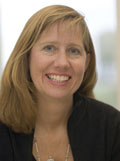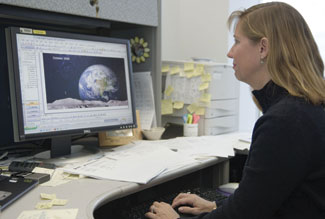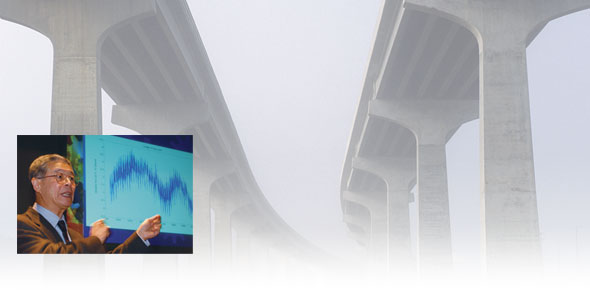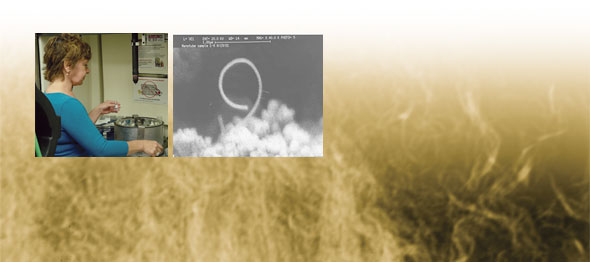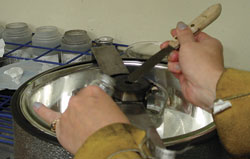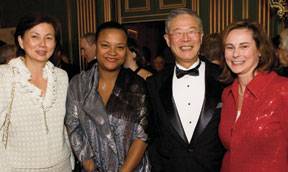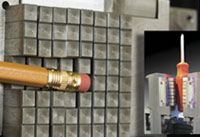|
|||||||||||||||||||||||||||||||||||||||||||
| volume 4, number 3: FALL 2006 |
|
||||||||||||||||||||||||||||||||||||||||||
|
[Links followed by * open new browser windows.] |
|||||||||||||||||||||||||||||||||||||||||||
|
The Innovative Partnerships Program (IPP)* at HQ established the Partnership Seed Fund to address barriers and initiate cost-shared, joint-development partnerships, providing “bridge funding” to enable larger partnerships and development efforts to occur. Goddard’s IPP Office managed the submission process for the Center, reviewing more than 50 preliminary proposals and then selecting and aiding the development of eight proposals for submission to HQ. “I was amazed at the magnitude of Goddard’s response to the Call given the tight timeframe,” said Darryl Mitchell, who led the effort for Goddard’s IPP Office. “So many innovators had some very impressive collaborations, and we’ll be working with them to further develop these partnerships.”
Goddard’s IPP Office congratulates the four projects that received HQ funding (see table). We also offer our sincere thanks to the hard work of the other Goddard researchers who developed full proposals: Laddawan Miko (Code 553), Dan Powell (Code 540), Wesley Powell (Code 564), and Diane (Betsy) Pugel (Code 553). Two military agencies have issued notices for funding of research and development (R&D) projects. Researchers are encouraged to consider whether their NASA mission work overlaps with these solicitations. With some modifications, existing project/proposal summaries (e.g., for IRAD funding) might be submitted as white papers as a first step in pursuing funding from these agencies: Agency: DARPA’s Defense Sciences Office Solicitation: Defense Sciences Research and Technology* (BAA06-19) Relevant areas of interest: New materials, materials concepts, materials processing and devices, and advanced mathematics Closing date: February 9, 2007 (white papers should be submitted earlier) Agency: Missile Defense Agency’s Advanced Technology Innovation Cell Solicitation: Broad Agency Announcement for Advanced Technology* (MDA/DV) (HQ0006-06-MDA-BAA) Relevant areas of interest: Radar systems; lasers and electro-optical systems; integrated active/passive IR sensor systems; computer science, signal and data processing; physics, chemistry, and materials; and mechanical and aerospace engineering Closing date: July 31, 2008 (white papers must be submitted earlier)
If you are interested in submitting a white paper or proposal, please contact Nannette Stangle-Castor (919) 873-1457 of the Goddard’s IPP Office. |
|||||||||||||||||||||||||||||||||||||||||||
|
|
What it is: This neutron “camera” enables remote, real-time detection and source localization of fast neutrons from any direction and over large areas and distances. Low sensitivity to gamma rays and effective neutron background subtraction allow for high sensitivity detection and precise source localization while allowing stand-off detection at distances up to 1,000 meters. What makes it better: The design allows neutrons to be detected from any direction. Its use of directional information allows very effective background subtraction, and its insensitivity to gamma rays enables accurate detection of fast neutrons at large distances. Furthermore, it can determine the neutron source location to within a few degrees. The instrument can be used as a stand-alone passive imager or with a neutron source for active detection. How it might be used: The device might be useful in a variety of passive and active neutron imaging applications, including port security, border monitoring, drug enforcement, and landmine and other explosives detection applications; remote sensing and oil discovery; quality control and nondestructive testing and inspection; medical imaging; and crystallography. Tech transfer status: As prototype development continues, Godddard’s IPP Office is contacting companies involved in neutron instrumentation or hazardous materials detection to better understand end-user criteria and constraints. Report your innovations on eNTRe*. For more information, contact Goddard’s IPP Office (6-5810).
|
||||||||||||||||||||||||||||||||||||||||||
Test your TTQ* *technology transfer quotient Intellectural Property (IP) Protection in Collaborations IP protection is when a patent or copyright is put in place to maintain NASA’s ownership of the inventions, designs, techniques, tools, devices, software, or other innovations.
|
|||||||||||||||||||||||||||||||||||||||||||
|
|
What have you been doing with Goddard’s IPP Office? I have been working with the IPP Office in looking for partnership opportunities both to bring innovative technology into NASA and to spin our technology out to industry. What kinds of partnership opportunities? With the help of the IPP Office, we recently identified an ideal partner—Carnegie Mellon University (CMU)—and successfully collaborated with them on an Applied Information System Technology (AIST) proposal. I do not believe our proposal would have been successful without this partnership and the value that Carnegie Mellon brought to the table. We are very excited about this opportunity to build a relationship with CMU while infusing the technologies of both organizations for an important scientific application. What technologies are those? We had developed Adaptive Sensor Fleet software to manage fleets of independent platforms, for example autonomous boats, to collaboratively accomplish a scientific measurement goal. Meanwhile, CMU had developed innovative techniques for “telesupervision,” which allows adaptive levels of autonomy in managing such a fleet. How will these two technologies be used together? The CMU product was an ideal user interface to our system and represented an area of technology that we hadn’t focused on. Under the AIST effort, the two systems will be used to drive a fleet of autonomous boats to study harmful algae blooms (HABs). In this case, the whole will definitely be greater than the sum of the two parts! We look forward to the first demonstration at the end of FY07. Are you pursuing other partnerships with IPP? Yes, we are also excited about the partnership with United Space Alliance (USA), which will leverage the strengths of each of our organizations to develop an important system for exploration. (Editor’s note: This partnership received funding through HQ’s Partnership Seed Fund.) What are these respective strengths? USA is uniquely qualified to operate manned missions and has many employees who do only that. GSFC is uniquely qualified to understand the lunar environment from a scientific and environmental standpoint. Working together, we hope to provide an information system that will make complex scientific information of greatest use in exploration decision making. How have you benefited from your work with IPP? IPP has been an excellent resource in identifying potential partners, partnering mechanisms, and even funding opportunities. My expertise is in technology development, and I do not have an awareness of these other areas. IPP enables me to focus my time on the technology development aspects, and then they facilitate the spin-in and spin-out processes.
What do you see as the value of technology transfer? I strongly believe in the IPP mission and its value to the taxpayers. Technology transfer can exponentially increase the value of NASA’s investments. If we properly research technology available in industry, we can leverage that rather than building capabilities from scratch. And by developing partnerships, we can bring additional expertise and perspectives in to solve NASA’s problems. Lastly, we can benefit the economy and the general public by transferring our technology to commercial applications. Do you have any advice for your colleagues? My advice would be to use IPP as a resource. I have found that if I throw a question at them—either regarding what technology already exists, what companies may want to commercialize our technology, or what potential partners have certain skills and capabilities—they are able to spend time doing the research to answer the questions. They can also do much of the ground work for getting partnerships off the ground. I can easily be busy with doing my primary job of developing technology for NASA requirements and not find time for technology transfer. It really doesn’t take much time if you share information and questions with IPP and let them help.
|
||||||||||||||||||||||||||||||||||||||||||
Goddard’s HHT Helps Scientists Analyze Highway and Bridge Safety
A little more than 3 years ago, Goddard signed an agreement that granted the Federal Highway Administration’s Turner-Fairbank Highway Research Center* (TFHRC) access to Goddard’s Hilbert-Huang Transform (HHT) technology and expert advice from the inventor Norden Huang (retired). Since then, Goddard’s technology has played a key role in TFHRC scientists’ analyses of traffic flow data, wind and traffic interaction with bridges, and damage detection in pavement and bridges. These analyses, which are performed for the Digital Highway Measurement (DHM) Project, are the first steps in a dramatic shift in the way state departments of transportation will be able to improve the safety and performance of the nation’s highway infrastructure. Goddard’s Technology Dr. Huang began developing HHT in 1995 as part of his oceanography research at Goddard. Unlike precursor technologies, HHT provides an effective method for analyzing nonlinear and nonstationary signals while improving the accuracy of linear- and stationary signal analysis. Because analytical measurements within many areas of science benefit from a quantitative measurement of nonlinear data, HHT is widely applicable to a broad range of fields, including medicine, electronics, the environment, and business. HHT was ideal for structural engineering analyses at TFHRC. Developing a New Use TFHRC conducts technology R&D to provide solutions to complex technical problems, thereby enhancing the safety and reliability of the U.S. highway transportation system. Dr. Huang met officials from TFHRC at a seminar, and discussions ensued on the potential use of HHT in highway research. These discussions eventually led to the 2003 agreement developed, negotiated, and administered by Goddard’s Innovative Partnerships Program Office. Under the agreement, TFHRC scientists collaborated directly with Dr. Huang to build an operational model of HHT for their own analyses and to build a knowledge base for using the HHT algorithms for the DHM project. This project uses a van driving at highway speeds to collect and analyze critical highway safety data, which can lead to better bridge and highway safety, design, and construction. “The HHT has been a critical element for accurate analysis of data from some of the sensors on board the DHM van,” explained TFHRC’s Morton Oskard. “The capability being created in the van represents the beginning of a paradigm shift in the way states will view and be able to carryout their stewardship of the nation’s highway infrastructure.” Benefits of Technology Transfer For TFHRC: As a result of working with Goddard’s HHT technology, TFHRC gained the ability to measure highway design performance, rate of deterioration, and remaining life, helping to improve the performance of future highways and bridges. TFHRC will be able to use these findings to improve future highway safety and contribute to improved quality of life. For NASA: The agreement enhanced NASA’s strategic technology objectives. As noted by Dr. Huang, “By sharing the HHT technology with TFHRC, NASA will also benefit by using the resulting knowledge to refine and further develop HHT and its use in other areas of research.” For example, stability analyses developed using HHT on vibration measurements at TFHRC are being used to benefit NASA research as well, particularly aero-elastic flight data at NASA Dryden Research Center. + Find out more about this HHT success.
University and industry researchers now have access to high-quality single-walled carbon nanotubes (SWCNTs) at a lower cost than ever before. How is this possible? Sold by Idaho Space Materials* (ISM) as its NOMEC 1556 product, these SWCNTs are manufactured using a Goddard-developed process. Goddard’s Technology Although carbon nanotubes were discovered 15 years ago, their use has been limited due to the complex, dangerous, and expensive methods for their production. However, Goddard’s Jeannette Benavides (Code 562) and Henning Leidecker (Code 562) developed a simpler, safer, and much less expensive manufacturing process for SWCNTs. This process’s key innovation was its ability to produce bundles of SWCNTs without using a metal catalyst, dramatically reducing pre- and post-production costs while generating higher yields. Since carbon nanotubes have a wide range of applicability, Goddard’s IPP Office began promoting the innovative SWCNT manufacturing technology at conferences, in print, and online in the hopes of finding a licensee. The technology caught the attention of Wayne Whitt, who was looking for an innovation with which to start an advanced materials company. Within a year he had founded ISM, and applied for a nonexclusive license for Goddard’s technology. Commercialization As license negotiations proceeded, Dr. Benavides met with company officials to demonstrate and fully explain the technology. Once the license was signed, she also provided her expertise regarding Raman spectroscopy to researchers at the University of Idaho’s Electron Microscopy Center, with which ISM was working on nanotube specimen characterization. “Dr. Benavides not only worked hard to develop the technology but also was very involved in the technology transfer process,” said IPP’s Darryl Mitchell who managed the development of the license agreement. “Her dedication was essential to the success of this agreement.” Once ISM’s production process had been perfected, the company launched its SWCNTs as NOMEC 1556 on August 1, 2006. Product orders have already been received from university researchers, who can purchase ISM’s SWCNTs at a reduced price. “I’m very excited to see that this agreement is now making CNTs more readily available, particularly for academic and other research programs,” said Dr. Benavides. “The fact that they now have access to lower cost CNTs bodes well for the future of nanotechnology.” Benefits of Technology Transfer For ISM: Licensing Goddard’s SWCNT manufacturing technology accelerated the launching of ISM and its premier product. “[It] allowed us to begin operations and rapidly commercialize an innovative product without the traditional R&D costs and time,” said ISM’s Mr. Whitt. “We were able to focus on process enhancement and commercialization, which resulted in significant improvements in yield and production capacity without sacrificing product quality.” For NASA: The out-licensing of its patented technology and ISM’s sales of NOMEC products generate revenue for NASA, which can be reinvested in additional space program research. ISM also represents a source for NASA to purchase low-cost, high-quality SWCNTs that could be used in space exploration and science missions. And Beyond: ISM is making its SWCNTs available to university and not-for-profit researchers at a reduced price. “ISM believes that carbon nanotubes will be a building block for a better world, making people’s lives better through a wide range of uses, including medical advances, fuel cells, video displays, solar cells, and a host of other applications,” explained ISM vice president Roger Smith. “Getting single-walled CNTs into the hands of researchers will help accelerate their transition from a conceptual idea to a practical product.” In addition, ISM is creating high-tech jobs in Boise, Idaho. The company currently employs 8 people and plans to increase the staff to 20 by the spring of 2007. + Find out more about this nanotube success. |
|||||||||||||||||||||||||||||||||||||||||||
|
The Innovative Partnerships Program Office is proud to announce the recent signing of seven partnership agreements.
This agreement will enable Aeroflex to develop a SpaceWire-based router with guidance from Goddard. The company will translate the multi-port router into application-specific integrated circuits (ASICs), enabling a variety of applications to connect through the router and communicate with each other, benefiting space-flight applications for both organizations and the aerospace industry as a whole. Specifically, NASA will benefit from being able to purchase ASICs from Aeroflex at a much more affordable rate than producing them in house. Multiple NASA missions may benefit from the ASICs provided by Aeroflex, such as the James Webb Space Telescope, Magnetospheric MultiScale (MMS) missions, and other satellite operations. BCG Wireless has licensed Goddard’s Hilbert-Huang Transform (HHT) technology to help improve signal reception capability in radio frequency (RF) communication devices. Initial testing at Goddard indicates that HHT applied to degraded RF signals can significantly reduce the noise in the signal, enabling better reception and more accurate signal transmission. BCG Wireless is looking into the applicability of this HHT capability for devices including radio frequency identification (RFID) chips and cell phone communication systems. BCG Wireless may be able to significantly improve the lifespan and signal reception of a variety of RF devices, including consumer products. NASA also may be able to use enhanced RF capabilities to benefit its own radiometers, telescopes, satellites, and other space program technologies. Goddard is providing support to Harris regarding the SpaceWire standard and the requirements for integrating it into the company’s electronics. Once Harris gains familiarity with SpaceWire, the company may go on to build SpaceWire-based electronics, such as those that Aeroflex is developing in cooperation with Goddard. In the future, as such components become more readily available, satellite providers will be more likely to adopt SpaceWire, which will enable faster development of designs at lower costs for NASA and the rest of the aerospace industry. NASA is being reimbursed for Goddard researchers’ near-term support to Harris. Under this agreement, students at Howard Community College will have the opportunity to gain real-world technology experience as they assess Goddard technologies and collaborate with faculty, Goddard researchers, and local mentors to develop commercialization plans and potential licensing opportunities. This agreement, as well as others previously signed with the University of Maryland–Baltimore County’s ACTiVATE program and the University of Baltimore, will enhance NASA’s strategic technology objectives, providing Goddard with assessment information about potential applications and licensing opportunities for possible technology transfer efforts. The company has licensed a multi-stage adiabatic refrigerator (ADR) technology to manufacture it for commercial availability. This technology enables continuous cryogenic cooling of items to milliKelvin temperatures without the need for liquid cryogens. Licensing this revolutionary technology to a company uniquely positioned to manufacture and market the hardware offers tremendous value both to NASA and to other research organizations. NASA will benefit by being able to purchase the completed CADR units from Lake Shore (for use in infrared detectors and telescopes) at an economical price. NASA’s possibilities for CADRs include infrared detectors for monitoring crops, ocean temperature, and atmospheric changes; generation of liquid rocket fuel for Mars exploration; and other detectors. Lake Shore plans to market the CADR units to research labs and universities, helping to further research in low-temperature physics and condensed-matter physics. TEDCO’s mission is to facilitate the creation of businesses and foster their growth in all regions of the state through the commercialization of technology. “TEDCO’s mission is closely aligned with our own,” said Nona Cheeks, chief of Goddard’s IPP Office. “This agreement allows us to leverage the state’s investment in technology-based economic development for the benefit of NASA as well as the state of Maryland.” Goddard’s agreement with TEDCO is designed to serve as a valuable link between Maryland companies looking to benefit from Goddard’s capabilities and technologies. The agreement will enable local industry and universities both to utilize Goddard research and development and to help achieve NASA missions faster and more cost effectively. Texas Instruments will work with researchers at Goddard’s Radiation Effects Facility (REF) to test and reengineer electronics that can withstand the effects of radiation in space. The agreement will enable the company to engineer and market radiation-tolerant electronics to serve NASA and aerospace companies that manufacture space-flight equipment. Goddard also will be able to apply the test data obtained under this agreement to other space electronics, understanding the impact of NASA’s current test methodologies on different sizes of instruments. |
|||||||||||||||||||||||||||||||||||||||||||
|
Goddard researchers and technology transfer personnel participated in two recent events.
Drawing about 38,000 visitors, the NBC4 Connected Expo (Sept. 16–17) provided Goddard with an excellent opportunity to reach the public, sharing the latest technology and detailing the ways NASA enriches lives. In addition to staff from the Public Affairs Office, Goddard’s IPP Office arranged for the participation of several researchers and their technologies:
Also on display were technologies supplied by Ted Swanson (Code 540). IPP appreciates the participation of all of these individuals. Goddard IPP chief Nona Cheeks shared some “lessons learned” at the 2006 meeting of the Mid-Atlantic Region of the Federal Laboratory Consortium for Technology Transfer (FLC-MAR). Ms. Cheeks presented two case studies to demonstrate how rights to intellectual property (IP)—particularly software—can be lost through interagency sharing and/or collaborative research with commercial contractors. The negative results of losing IP rights include lost revenue for the agency and inventors. The presentation and discussion provided valuable insights on how to prevent such “missed opportunities.” In addition to this presentation, Goddard personnel won two FLC-MAR awards. |
|||||||||||||||||||||||||||||||||||||||||||
|
FY06 Ends with Many Awards Several Goddard innovators received prominent awards from outside organizations in recent months.
As reported in the Summer 2006 issue of Goddard Tech Transfer News, Norden Huang (retired) had been named a finalist for this award from the Partnership for Public Service*. IPP is pleased to announce that Dr. Huang was selected as the winner of the Science and Environmental Medal for his work related to the Hilbert-Huang Transform (HHT) technology. “I am so pleased to receive this award,” said Dr. Huang, who is now with the Research Center for Data Analysis at National Central University in Taiwan. “I’m particularly grateful to [the IPP] for seeing the potential for my technology. I have greatly enjoyed seeing HHT make advancements in so many areas.” technology.
R&D 100 Award Called the “Oscars of invention” by the Chicago Tribune, this annual award from R&D Magazine recognizes the 100 most innovative and technologically significant new products on the market. Goddard’s conformal robotic gripper, developed by John Vranish (retired) won an R&D 100 Award* for 2006. The technology is a unique gripping mechanism that has the potential to revolutionize robotics by eliminating the need for specialized end effectors and grippers. Originally designed for use in NASA’s lunar robotics missions, the gripper has applications in manufacturing, medicine, and other industries that rely on robots to use tools and manipulate objects. FLC-MAR Excellence in Technology Transfer Awards Goddard's IPP Office is pleased to announce that two technology transfer efforts have been recognized by FLC-MAR*:
The following are awards issued by ICB during the fourth quarter of FY06. Space Act Board Awards
Software Release Awards
Tech Briefs Awards
|
|||||||||||||||||||||||||||||||||||||||||||
|
|||||||||||||||||||||||||||||||||||||||||||
|
You can report new project technologies through the online eNTRe* system. |
|||||||||||||||||||||||||||||||||||||||||||
|
Chief: Nona Cheeks Goddard Tech Transfer News is the quarterly magazine of the Innovative Partnerships Program Office (Code 504) at NASA Goddard Space Flight Center in Greenbelt, Maryland. This magazine seeks to inform and educate civil servant and contractor personnel at Goddard* about actively participating in achieving NASA’s technology transfer goals:
Please send suggestions or feedback about Goddard Tech Transfer News to the editor or go to our online feedback system. |
|||||||||||||||||||||||||||||||||||||||||||
|
|||||||||||||||||||||||||||||||||||||||||||







